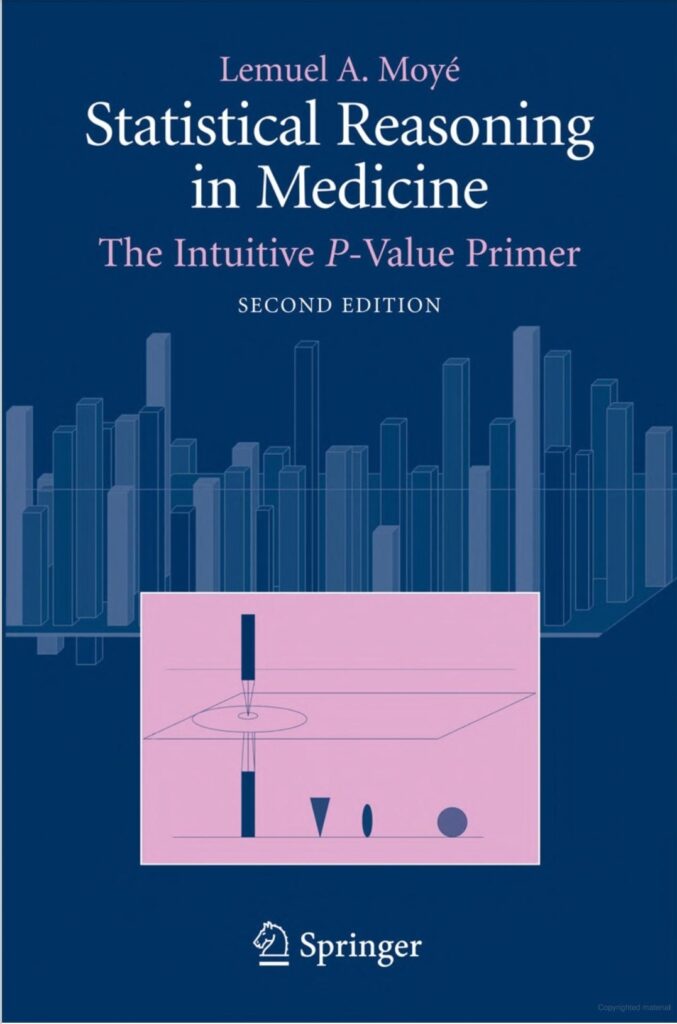This book is for everyone in health care who requires a nonmathematical answer to the question “What is a p-value”. Statistical Reasoning in Medicine: The Intuitive P-value Primer focuses on both the underlying principles of statistical thought in medicine and the ethical interpretation of p-values in health care research.
A physician confronted with a new finding in her field, a director of a pharmaceutical company analyzing a series of experiments, an expert sitting on an advisory panel for the government, or a judge assessing the scientific aspect of a lawsuit must have an understanding of p-values and the underlying statistical thinking that guides their interpretation. If you are a decision maker without in-depth training in statistics, but now find that you must grapple with the thorny theory of statistical reasoning and the slippery issue of p values, then this book is for you.
With an emphasis on patient and community protection, The P-value Primer develops and emphasizes the p-value concept while deemphasizing the mathematics. It also provides examples of the p-value’s correct implementation and interpretation in a manner consistent with the preeminent principle of clinical research programs: “First, do no harm”.

Excerpt from P-value Primer
Physicians and the Patient Perspective
Physician training focuses on the individual patient to the exclusion of the population. We may call this the “single patient perspective”. The single patient perspective is embedded in medical students from their first year introductory courses. The detailed instruction in anatomy, histology, biochemistry, and physiology we received was not so much to enhance our understanding of the constitution of the population, but to deepen our understanding of the structure of the individual. It was a discussion about facts. Exams were on facts, not on variability.
As medical students, we are trained to develop thorough and exhaustive differential diagnoses, compiling a complete list of possible explanations for the symptoms and signs the individual patient presented, with little thought given to the frequency of the disease in the population. In my medical education, a seemingly disproportionate emphasis was placed on rare diseases (e.g., Whipple’s disease, or Tsushugamuchi fever). This exposure trained us to identify the one unexpected patient who might have that unusual disease. In essence we were taught to bring “the rare to bear” in developing a patient’s diagnosis.
We remember the first time that we had responsibility for performing a history and physical.[1] Each of these experiences inculcates the “single patient perspective” i.e., our focus must be on the one patient before us.
Occasionally, during a short course in either epidemiology or biostatistics in the middle of medical school, we faced another point of view. General discussions about measuring effects in populations presented a perspective that suggested that there was a larger context for our work. However the concept was already a foreign one. After all, wasn’t the best way to mend the health of a population to allow well educated, individual physicians to treat individual patients, one at a time? Trained to place the patient in the position of pre-eminence, the new population-perspective was alien. Upon graduation, we took a patient-based, not a population-based, oath.
As house officers, we focused not on populations of patients, but on the few (although at the time it seemed like the many) patients on the wards, floors, and units that we covered. We attended lectures to learn how we might better help the patients directly under our care. Private practices were built one patient at a time, one family at a time. Every patient interaction offered a potential surprise or pitfall, and therefore required our complete attention. Since the most important patient that we would see is the one we were currently treating, all of our skills and energy had to be focused there.

Research and the Population Perspective
The patient-perspective remains preeminent for good and undeniable reasons. Examining, identifying and treating the patient for his or her benefit alone is a tremendous burden for which we are disciplined and trained. We should not turn our faces from this challenge.
Yet the principles of research are different from those of the medical practice. In fact, many physicians believe that in order to understand research tenets, they must embrace concepts that they have been specifically trained to shun.
One example of this disconnect between research and medical practice principles is the concept of the “average” patient. The average blood pressure produced by the active group in a clinical trial may be only two or three mm/Hg lower than in the control group, a finding heralded as an important advance by the research community. However, physicians treating patients in the community are not impressed with the change, asking how a 2-3 mm Hg reduction could possible matter in a patient where the daily stresses of work and family living generate changes in blood pressure that are more significant.
Another confusing message for the physicians laboring to understand research issues is the concept of variability. Treating physicians clearly understand that patients are very different from one another, unique in an infinite number of ways. We take this into account, adjusting the patient’s visit schedule in accordance with the patient’s stability or our concerns.[2] We never think of modifying variability. Yet, researchers become experts at controlling, adjusting, or even removing variability.
The difference between the two groups of workers is perspective. Physician views develop from the patient-based perspective, while researchers are commonly population-based. Each perspective uses different tools because their goal’s are different.
[1] For me, it was an adult, deaf-mute male at North Shore Hospital on Long Island, New York, in March 1976.
[2] The simple, often mocked monitory “call me in the morning,” is a maneuver acknowledging that the doctor, not knowing in precise detail what will happen to the patient, insists on new informa
